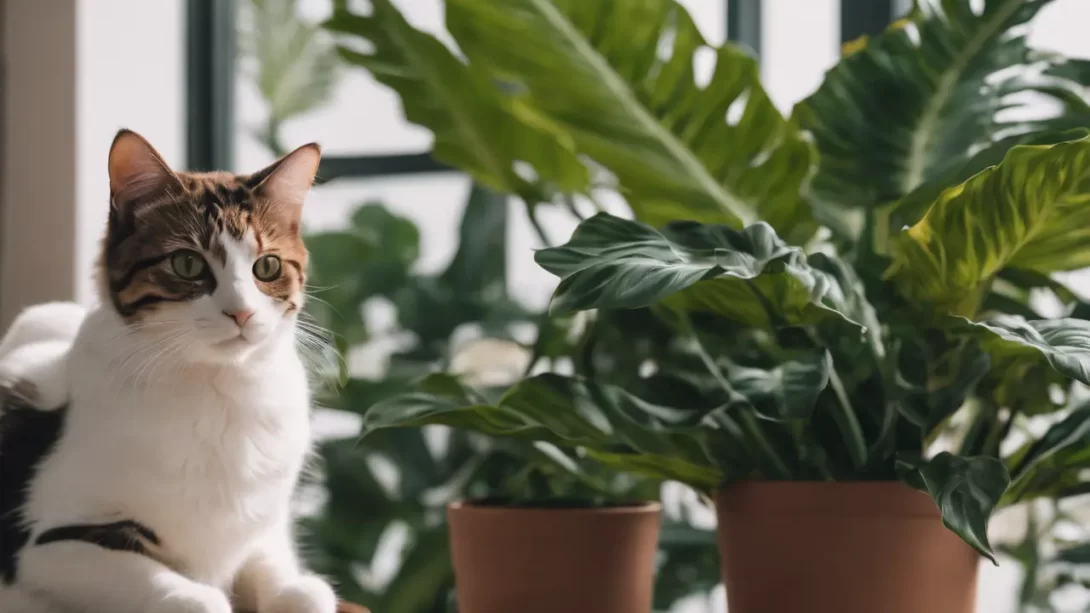Calathea, known for its striking leaf patterns and colors, is a popular choice among indoor plant enthusiasts. As cat owners often find their feline friends nibbling on houseplants, it’s crucial to determine whether such plants are safe. This article aims to address concerns about the toxicity of Calathea to cats, ensuring that pet owners can maintain a healthy, green space without compromising the safety of their beloved pets.
Calathea
Calathea, part of the Marantaceae family, is celebrated for its diverse and visually striking leaves. Varieties like Calathea ornata, Calathea makoyana, and Calathea zebrina feature unique patterns and shades, making them attractive as decorative houseplants. These plants are not just favored for their beauty; they are also known for improving indoor air quality. Calathea plants prefer indirect light and high humidity, making them suitable for indoor environments, but they require careful attention to watering and temperature to thrive.
General Considerations for Cats and Houseplants
Cats are naturally curious creatures and often explore their environment by chewing on plants. This can be problematic as some plants contain toxins that can be harmful to cats. Symptoms of plant toxicity in cats include vomiting, diarrhea, drooling, lethargy, and in more severe cases, difficulty breathing or swallowing. Understanding the potential risks houseplants pose to cats is vital for creating a safe indoor environment for our feline companions.
Calathea’s Toxicity Profile
When it comes to the safety of Calathea for cats, there is reassuring news for pet owners. According to the American Society for the Prevention of Cruelty to Animals (ASPCA), Calathea is not listed as toxic to cats. This means that if a cat nibbles on the leaves of a Calathea plant, it is unlikely to suffer from serious poisoning. However, it’s important to note that individual cats may have different sensitivities, and while not toxic, ingestion can sometimes lead to mild digestive upset due to the unusual plant matter in their diet.
Preventative Measures for Cat Owners
While Calathea is non-toxic, preventing your cat from chewing on houseplants is still a wise practice. One effective method is to keep plants out of reach, either by placing them in high or enclosed spaces. Alternatively, you can use natural deterrents like citrus peels or sprays, as cats generally dislike these scents. Additionally, providing your cat with safe and appealing alternatives, such as cat grass or catnip, can divert their attention away from your houseplants.
What to Do If Your Cat Ingests a Plant
In the event that your cat does ingest part of a houseplant, monitor them closely for any signs of distress or illness. While Calathea is not toxic, ingestion of any non-food item can potentially cause gastrointestinal upset in cats. If you observe symptoms like vomiting, diarrhea, or unusual behavior, consult your veterinarian. It’s always beneficial to have information about your local emergency vet services at hand, especially in cases where you suspect your pet has ingested something harmful.
Conclusion
In summary, Calathea is a safe option for households with cats, as it is not listed as toxic by reputable sources like the ASPCA. This is great news for cat owners who also love cultivating an indoor green space. However, even with non-toxic plants like Calathea, it’s wise to prevent your feline friends from making a habit of nibbling on greenery. Some cats might experience mild discomfort even from non-toxic plants due to the unfamiliar plant matter.
Creating a harmonious living space that is both pet-friendly and plant-friendly requires a bit of planning and vigilance. By employing preventive measures like placing plants out of reach and using natural deterrents, you can protect both your plants and your pets. Additionally, always be observant of any changes in your cat’s behavior or health, particularly after they have had access to houseplants.
Remember, the goal is to foster a safe and enjoyable environment for all members of your household, furry ones included. With the right approach, you can enjoy the beauty of Calathea plants without compromising the well-being of your cats. Happy gardening, and here’s to a peaceful coexistence between your plants and pets!



